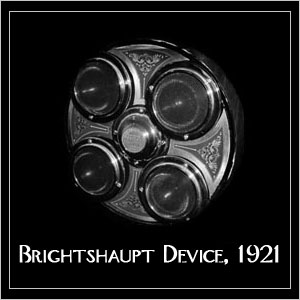Brightshaupt Devices
The Archivist | October 18, 2007
In 1921, Aemelia Brightshaupt, a Swiss immigrant, began to build a small toy for her numerous grandchildren, most of whom resided more or less under their various parents’ supervision in prodigious rooms on the Upper East Side. Ambrose Brightshaupt’s success as a financier in the 1890s boom had allowed him and his wife to purchase no less than twelve adjoining apartments in a single building, and after they had removed a large number of walls and raised staircases through an only slightly lesser number of ceilings, they invited the entire family to join them in their retirement. The result was a labyrinthine house within a house, and the Brightshaupt grandchildren, of which there were seventeen, had run of the place.
Aemelia became obsessed with radio after her husband’s death in 1919. The War, she once said to her son, was too much for him to bear witnessing. Her predilection for electronics and mastery at such an advanced age is truly startling, and it cannot be denied that the world has overlooked in her a very great genius. Her children remember her as a sly and reclusive woman, given to cryptic smiles and long evenings in her study, a room in the rear of the great apartment, and the only one with a lock on its door. In this room was an astonishing array of radios in varying states of repair and disrepair. She did not speak much, a quiet soul whose command of English had never been total, and so in that May of 1921 her unruly brood were surprised to be assembled outside her mythic door to be given “a very great present.”
The very great presents were painstakingly assembled and painted metal discs with four large, though dormant, lights set into their surfaces. There were seventeen of them, and Brightshaupt never created any further discs, even when her youngest daughter was delivered of twins the next winter. Gathering her family around her, the old Swiss woman with her white hair in a neat bun told them how to play with their new treasures.
Red, blue, green, yellow, red, purple.
By all the available memoirs, this was the first sequence assigned to the children. They were to make this strange metal disc repeat the sequence. She gave the oldest ones a small notebook with an address in it and told them to run along, there would be hot buns and cocoa at dusk. Aemelia gave over the toys and told them nothing more. She shut her study door firmly behind her and disappeared into the faint, silvery sounds of static.
All seventeen Brightshaupt children obediently wound their way through the city to the address they had been given, which was a tall, Gothic radio transmission tower. Standing below it in a little circle, their little discs lit up. The lights wavered, green, blue, orange, white. Ghostly voices rose up from them, a blue light singing Italian opera in a thready, unearthly soprano, the orange one whispering about butlers and stolen silverware, the white reporting the stocks in a buzzing, indistinct monotone. The children were delighted, scrambling up stone walls and brownstone stairs to “get” different frequencies, screaming with laughter when one of Grandmother Aemelia’s colors shone true and clear. A middle child, Gibson, often overlooked, was the first to manage the correct sequence. He was declared the winner, bought an ice cream by the eldest boy, and carried home like a Roman champion, their rag-tag triumph proceeding down Fifth Avenue with songs and dancing.
In that charmed summer of 1921, Aemelia emerged from her study each morning with a new sequence for the little gang to discover. Each morning the address book contained another radio tower for them to explore. The Brightshaupt children ran from their cavernous rooms and into the city, becoming wild, a band of hunters seeking out frequencies with ruthlessness and cunning. They began, without prompting, to mark with colored chalk the best places in the city for the receipt of blue frequency, or red, the best place to hear the Yankees play while the disc flashed violet, the ideal location, if one hung upside down from the knees, to hear the barest whisper of a radio play concerning a beautiful and wretched refugee who would not abandon her lover in the desert. They marked these blessed spots, these sites of radio-grace, with their own sigil: BH contained within a triangle. These signs appeared all over the city that summer, and police worried over some new nefarious criminal element while the children stood on their tiptoes to get better reception, brighter colors, sweeter music. The first to achieve Grandmother’s sequence always received their ritual ice cream with much pomp.
Aemelia Brightshaupt died in 1925, by which time she had twenty-one grandchildren, some of whom still reside in the hidden catacombs of that vast apartment, despite the tidal changes of zoning restrictions. After the funeral, the children went solemnly to the first of their towers and huddled together, carefully balanced on the rooftop of an accountant’s office, the only place they had ever found which made the disc-lights flush close to black, a deep, strange purple. The faint notes of a grim organ march floated away from them on the wind.
The original seventeen guarded their secret game fiercely, and if not for little Gibson having become a journalist, they might never have become known, and Aemelia Brightshaupt, obscure saint, lost to dim and dusty memory. It is not beyond reason to call her the inventor of the handheld game; further connections to locative games such as geocaching are inescapable. Only eleven devices are accounted for today, and none has ever been available for made commercial sale or use.
[[Archive Group: Attic. Lockwords: Portable Devices, Warchalking, Tether Systems, Alternate Power Transmission, Feral Networks. Last Accessed 9.001.6.7.7, UIN# (47)663.5-9]]
Comments are closed.
-->



